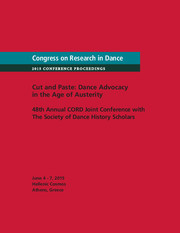No CrossRef data available.
Article contents
Shampoo Dancing and Scars–(Dis)Embodiment in Afro-Contemporary Choreography in South Africa
Published online by Cambridge University Press: 04 April 2012
Abstract
It could be argued that in no other colonised country were dancing bodies more destructively subjected to disempowerment and disembodied (Merleau-Ponty) than in Apartheid South Africa. This paper will review Mamela Nyamza, Celeste Botha, and Megan Erasmus's works to comment on choreographic choices that subvert power in South Africa. What is imposed in a transformation and libertory environment and by whom? The politics of movement discussion by Sylvia Glasser's (1991) “Is Dance a Political Movement?” will be extended, and Sherry Shapiro's (2009) writings appropriated to illustrate how hair sustains a normative position for the multiple users and recipients of contemporary dance. Can the scars of Apartheid be healed through Afro-contemporary dance choreography over time?
- Type
- Research Article
- Information
- Copyright
- Copyright © Gerard M. Samuel 2010


